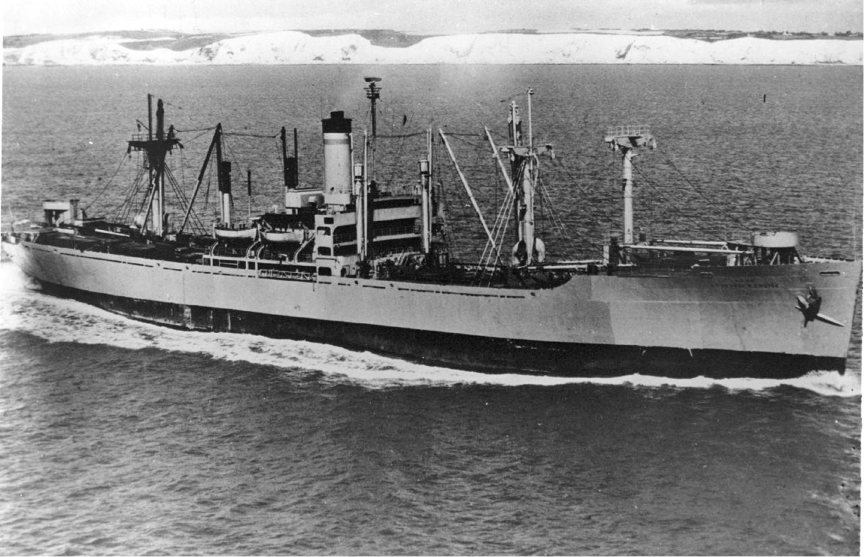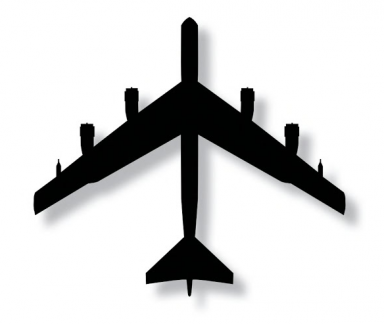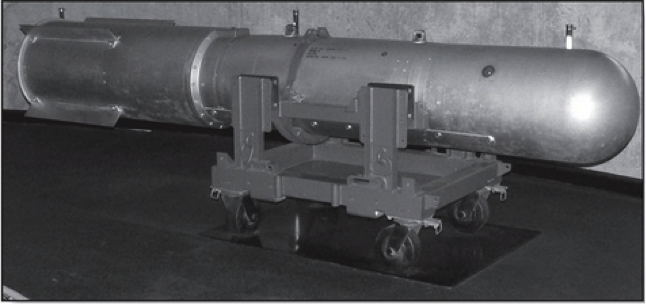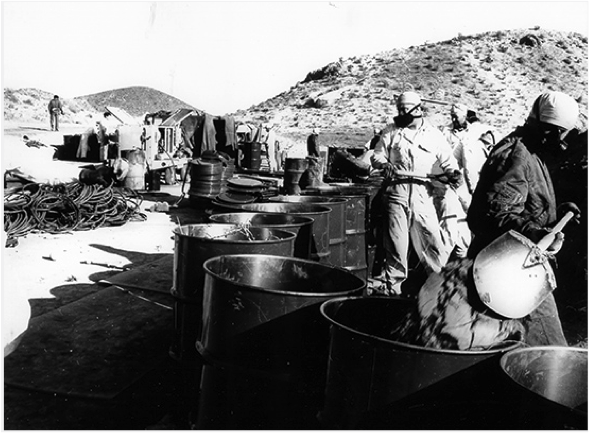On January 17th, 1966 at 9:22 in the morning, a B52-Bomber from the US Air Force collided mid-air with an Air Tanker-KC135 during a supply drop at an altitude of 9450 meters. The cabins from the planes crashed into Palomares, a village 80 km from Carthagena in the province of Almería, Spain. Debris fell into the Mediterranean and blanketed the streets, hills, fields, and beaches. Amongst the debris, there were four thermonuclear bombs.
Some people living in the village, which is most widely known for its tomatoes, alfalfa, and olive production, were shocked out of their daily routine by a large crash, sprays of fire, and monstrous iron scraps falling from the sky. While the cabins were crashing down to earth and the bits of smoking metal were scattered around, some witnesses reported seeing at least two parachutes, at the end of which some unknown objects were suspended. It would be a few days later until they spoke of thermonuclear bombs.
It was during his breakfast meeting that American President Lyndon B. Johnson was informed and Franco cannot be counted on to spontaneously tell his people and the world the extent of the truth and concerns. It was Moscow Radio that was the first to do so, and with a near-total incredulity announced that the south of Spain was contaminated by lethal radioactivity.
The B52 was transporting four 1.5 megaton thermonuclear bombs each for the operation “Chrome Dome.” This protocol, starting in 1961, consisted of having 24/7 fly-overs in Alaska, Canada, Greenland, and Southern Europe with bombers prepared to inflict instant atomic retaliation to Russia in the case of a similar attack by Russia.
Spain had signed with the United States in 1953 the Madrid Pact that permitted the U.S. Air Force and the U.S. Navy to open bases in Spain. This pact, desired by General Franco, had two advantages in his eyes. It allowed Spain have assistance from the USA in case of external military aggression and allowed the national army to rebuild its forces thanks to $500 million in aid from the U.S. Military Assistance Program between 1953 and 1963. Additionally, the supplemental financial aid of $1.3 billion delivered by the United States during the same period allowed Spain to jumpstart its economy despite its exclusion from the Marshall Plan. The Madrid Pact was prolonged in 1963, and the ability for the U.S. Air Force’s B52s to run in flight refueling over Spain was part of some of the new confidential clauses included. The periodic meetings in the sky between KC135s, refueling planes, and the B52s were evidence for many observers. The presence of atomic bombs in the bomber’s holds remained only a hypothesis.
The immediate human cost was seven dead amongst the planes’ crews, and four survivors of which three were recovered in the ocean by fishermen. There were no victims amongst the local population.
In the middle of the afternoon, 49 US Army scouts were dispatched in the area by helicopters. One bomb was spotted 300m from the beach in a hilly region. It was dented, but it had not lost its integrity. The parachute had worked. It had fallen on the banks of a dried up stream, and the internal mechanisms to start the explosion had not been smashed upon impact. The rad detectors do not panic.
At first light on January 18th, the search team started out again with the help from the Civil Guard and the second bomb was located at 9:30 in the morning at the bottom of a ditch. This time, the parachute and other bolting mechanisms had not worked. The primer detonator had been partly fused while falling down or crashing on earth. The debris was dispersed in a 100m radius and the contamination of the nearby environment by plutonium was immediately suspected.
One hour later, a third bomb was discovered in turn. It had also been damaged by the primary chemical explosives within, and its parachute had also not functioned. Debris was visible within a 500m radius.
The fourth thermonuclear bomb was not found. (See below: “Searching for the lost fourth bomb”)
The U.S. Air Force was not at all prepared for detecting the plutonium-239 dispersed at the site of a plane crash. Even though the United States and its allied countries, for the needs of the Cold War, were always overflown by large aircrafts ready to release atomic bombs, no post-accident doctrine on the decontamination of soils, farmlands, nor the environment was ever created. The only radiation redectors available were the PAC-1Ss. They were difficult to manage in uneven terrain, and learning how to use one is difficult. As a consequence, the measurements of alpha radiation were imprecise when they were used. The PAC-1Ss arrived at the end of a few days from eight American bases in Europe, one from Africa, and 16 from the United States.
230 hectares westward from the center of the two major sources of contamination from the bombs was partitioned off. It spanned the entire town of Palomares from end to end.
Beginning in February, the American experts directed by Wright Haskell Langham, most widely known by the name Mister Plutonium, proposed to the Spanish government a protocol of which the major clause was the removal and scouring of five to six meters deep of all of the heavily contaminated land and the burying it in watertight pit.
After 15 days of discussion, the Spanish government, under pressure from regional populations, the national press, and public opinion imposed a fundamental reversal: all of the earth containing more than 88,000 becquerels per kilogram (Bq/kg) of plutonium would be gathered and transported to the United States. The contaminated soil containing less than 88,000 Bq/kg would be washed and ploughed to dilute the superficial value until it was considered acceptable. Any plant more than 600 Bq/kg would also be transported to the United States. Any one below the level, it would be burned.
The American soldiers were charged with recovering the rubble from the wreckage, any confidential documents, extracting by hand or with a shovel the clumps of earth, and cutting the contaminated vegetation with machetes. They wore, only if they wanted to, surgical masks considered by Mister Plutonium and his team to be purely psychological placebos. The soldiers that followed the orders were also equipped with plastic gloves, non-disposable jumpsuits, and some boots. Mister Plutonium explained to the troops that if this purely form-focused uniform was worn systemically, the inhabitants of Palomares and neighboring villages would unnecessarily worry themselves and demand that they too should have individual protection. The joint decision between Spain and the United States had been from the beginning of the crisis to not evacuate the population. Spain did not want to harm its steadily rising tourism industry in Andalusia and the United States did not want to worry the other countries where B52 flyovers were occurring, nor did they want to stir up additional tensions with the governments and the public opinions of countries housing strategic military bases.
If American soldiers noticed they had contaminated their skin, they were instructed to wash with a bucket of water and check it again afterwards. It was only January 24th and the February 3rd when decontamination showers arrived in different work sites. If the clothes were deemed contaminated, the soldiers were instructed to exchange them and wash the contaminated clothes on their own time. The cleanup had initially been announced to last just a few days and many of the participants were short on clothes. Typically, each team of soldiers would stay two to three weeks in one place. Upon returning to their base in Germany, the clothes and other objects used daily by the bomb-sweepers of the seventh army were found to be radioactive well above levels considered safe. It was then that the control protocol within the base camp at Palomares was enforced.
One 765 cubic meter pit was dug with the engines dedicated to the picking-up of the crashed military planes. It was said to be a temporary storage for garbage awaiting a final decision for its ultimate destination. When it became full, it was covered up by the soil from other excavation, and thus it was seemingly forgotten after a second trench was opened up.
12,000 cubic meters of vegetation waste contaminated by plutonium-239 was burned. The open burning took place on the dried up riverbed, the same one where one of the damaged bombs was discovered. It was done at night when the winds carried the smoke towards the ocean. The tracks left by the trucks were regularly washed with water or a light diesel spray to prevent the contaminated dust from rising. The trucks regularly passed under a jet on a platform in order to be washed. Many little white houses, typical of Andalusia, and the network of low walls were pressure washed with water and detergent to obtain contamination levels considered safe. There was no collection of the contaminated water.
Between March 17th and March 24th, 1500 tons of polluted ground up earth and vegetation placed in 4810 barrels was put on board the Boyce, a liberty ship constructed in 1945, a sort of domestic aid ship in the service of the U.S. Navy that usually carried people and different materials between American bases and to war efforts around the world. The crew aboard the Boyce was a civil one.
The U.S. Navy requested that each barrel had “Poison Radioactive Material” marks on the top, on the side, and on the bottom in blue or red. The U.S. Air Force and the Department of Defense were in opposition to this, citing the need to conform to the doctrine of discretion that had guided the operation since the beginning.
The barrels were filled with shovels and operated by hand by around fifty members of the U.S. Air Force. They wore white jumpsuits, gloves, hair covers and… surgical masks. After being filled, the lids were soldered in place. It was only upon arrival in Charleston, South Carolina that the barrels were labeled with “Poison Radioactive Material” before being transported with an escort to the Savannah River radioactive storage site, around 100km from Charleston.
March 24th, just before the Boyce’s departure across the western Mediterranean sea and the Atlantic ocean with her shipment of anonymous barrels, the American general staff released the following and unwise communication (excerpt): “The Boyce is going to embark for the United States later in the day. We believe we have accomplished our mission of putting the Palomares region back into its original state before the accident.”
 The Lt. George W.G. Boyce. Photo from the William Zarkas collection.
The Lt. George W.G. Boyce. Photo from the William Zarkas collection.
Searching for the lost fourth bomb
After the discovery of the first three bombs, the efforts from search teams were concentrated on the missing bomb, both on land and at sea. On land, the essential problem is to delimit the potential areas where the bomb could have been dropped. The first week was difficult, as the search teams did not have a precise map of the region available to them. Starting January 24th, the first information arrived from the aerial division. Each piece of visible metal debris was marked on a map. There were a myriad of theories on the destination of the lost fourth bomb: the bomb would have collided with a scrap metal at high altitude. Following the shock, the primary explosives would have detonated and the bomb would have fallen near the plane’s wreckage. This is where preferential research is carried out. The topography is particular. It is scattered with holes, crevices, and other natural depressions, along with different wells and cavities from ancient mineral mining activities, all of which were possible hiding places for the bomb and its debris.
Beginning in February, the searchers began to explore these places: they began marking different spots and examining them. They are subject to radiological detection and are mapped. On February 23rd, a geologist arrived on the spot in order to consult with the searchers. This hunt for the bomb lasted until March 3rd. 15 square kilometers were explored. All of the objects discovered were clearly identified as debris from the plane, the cabin, and its equipment. However, nothing indicated a lead to the location of the fourth bomb. Furthermore, after examining 232 potential bomb “traps”, it was decided to end the search on land. Another lead seemed promising: according to the testimony of a fisherman, the day of the accident, a parachute about 20m long fell from the sky and disappeared into the sea.
March 8th, one week before the localization of the missing bomb and a month before its recovery, the American ambassador Angier Biddle Duke and the Spanish Minister of Information Manuel Fraga Iribarne orchestrated a stunt for the media: they bathe in the sea at Mojácar about 10 kilometers from Palomares in the presence of 63 journalists. Upon exiting the water, Duke was delighted: “If that’s radioactivity, I love it!”
The maritime search was growing steadily. The U.S. Navy employed 34 boats, 3426 crewmembers, acousticians, and deep-sea divers. 42 days after the accident, a significant echo was detected by an acoustician which corresponded with the testimony of the fisherman. The trajectory of the mysterious object was retraced. Having fallen to a depth of 650 meters, it was poised on the edge of a deep-sea crater. Then, probably due to the force of the current, it slid down the furrow of a canyon. It then descended down to a depth of 777 meters. Multiple times, the submarine Alvin attempted to follow its tracks. It was however, because of the battery constantly running out of electric power, forced to resurface regularly which slowed down the search efforts. Finally, on March 15th, two weeks later, the object so heavily coveted was named contact #261, and seemed to be accompanied by a parachute. After the failure of a first pick-up, the object was once again lost. On April 2nd, it was finally spotted a second time at a depth of 850 meters. Everything indicated that the elusive object was certainly the missing bomb. However, it remained hidden beneath that which resembled a parachute. A hasty recovery effort began. The potential bomb could descend to a depth of 1200 meters and would no longer be recoverable if they did not act quickly. Many attempts at recovery failed: the first one led to another loss of the bomb. Finally, April 7th was the day of success. What effectively turns out to be the fourth lost bomb is hoisted aboard the USS Petrel after 81 days of immersion, at the end of a spectacular operation that had lasted 3 months and that had prevented hundreds of fishing boats to operate in the area. The fishermen complained and demanded compensation. Even after the bomb was recovered, the fish were no longer sold.
In 2001, the University of Seville published in the Environmental Pollution journal a worrying study. The samples taken from the critical zone, said to be returned to its original state by the American team, showed levels of contaminated soil reaching around 60,000 Bq of plutonium per square meter. For comparison, in France, the average concentration deemed safe would be 50 Bq/m2 for plutonium. Around the Marcoule’s nuclear sites in the lower Rhone valley, the concentration is 120 Bq/m2 with peaks of 270 Bq/m2. Traces of plutonium that are well above the average levels turned up on the Spanish coastline and were detected in different algae. The plutonium had supposedly migrated into the sea due to storms and frequent floods in the region.
Other samples taken showed the presence of americium-241 in high levels (between 10,000 and 34,000 bq/m2) notably on the platform where the barrels destined for the United States were filled and grouped. In France, the average activity of americium-241 would be 20 Bq/m2. Americium, the next element in plutonium-239’s decay series, is more toxic than its ascendant.
In 2010, some European inspectors visited the site at Palomares due to article 35 of the Euratom treaty that stipulated that “Each Member State shall establish facilities necessary to carry out the continuous monitoring of the levels of radioactivity in air, water, and soil and to ensure compliance with the basic safety standards. The European Commission has the right of access to such facilities in order that it may independently verify their operation and efficiency.” They noted that Zone 2 where the platform for the gathering of the barrels and the point of impact of one of the bombs was insufficiently fenced in and learned that hunters regularly went there to kill rabbits. The meat of the rabbit had never been analyzed because the rabbits did not constitute a significant portion of the regional diet. They also learned that many metallic debris were collected as souvenirs after the departure of American troops from the theoretically forbidden area. These rumors were not confirmed. The times have changed, and now zone 2 is wanted by housing developers to build apartments and hotels. The Commission also noted that the air collectors designed to measure the radioactive dust were damaged and learned that after the accident, starting in 1988, some melons had been grown in this parcel of land. Consequently, plastic from the agricultural work littered the area.
In Zone 3, adjacent from Zone 2, two water tanks were installed in order to spray the melons in Zone 2. The Commission noted that the intensive farming and housing development was encroaching upon the contaminated areas. One house was used by the CIEMAT (Ministry of Science and Innovation) as a garage and warehouse for different equipment. CIEMAT took core-samples beneath the uninhabited house to assess the progression of the contamination in the underground soils.
In Zone 6, north-east of Palomares, the rabbits were numerous and attracted poachers. The Sierra Almagrera is rocky and steep. The town of Villaricos is nearby. There is no farming in the region. The fence is easy to cross, and the radiological danger is not clearly signaled. The Euratom’s team learned too that bordering the southern part of the zone, a Dutch pharmaceutical laboratory (Deretil) produced in its workshops 40% of the compound Amoxicillin and that an English contractor wanted to construct a housing development project bordering the zone with a panoramic view of the Mediterranean. A “hunter’s hut” was found in a hill within the zone for poaching birds in the area.
In its conclusions, the Euratom’s team underlined that Zones 2, 3, and 6 risk are able to expose the civil populations to doses higher than 1mSv, and even in some cases higher than 5mSv per year. The Commission recommended that the fences be reinforced and well-maintained, that the surveillance program be enlarged to include the poached rabbit meat that had become a part of a local traffic. Above all, the Commission considered it imperative to rid the region of the plutonium and store it in a secure long-term location. Assistance from the United States seemed indispensable to them, knowing that Spain does not contain a storage center for radioactive waste contaminated by plutonium. The Commission from Euratom provided in particular in their conclusions that plutonium and the other radioactive contaminants are long-lived (24.000 years for plutonium-239 and 432 years for americium-241).
The after-Palomares accident was also the subject of monitoring by CIEMAT. This study was co-financed by the United States up until 2009. The Palomares Radiolagical Monitoring Program (PURP) remains discreet about the health effects of the event despite 5000 urine samples from the inhabitants. They are tasked with assessing the plutonium content in organisms and the elimination kinetics of it. According to the CIEMAT, 11% of the 1000 inhabitants under observation were contaminated by the plutonium from the accident. The observed levels are said not to be able to trigger cancers. In an article published in 2017 by the Revista Clinica Españolam two doctors from Almeria regrettably noted that since 1966, there has not been any epidemiology study worthy of the name on the effects of the accident.
The CIEMAT is more conclusive on the contamination of the soils. Beginning in 2007, comprehensive investigations over an area of 660 hectares had resulted in the prevention of all agricultural activity, including residential and commercial gardening, in a space of 41 hectares where the plutonium levels were the highest. The CIEMAT proceeded regularly to take samples of the air, vegetation, milk, goat meat, mutton, and snails. It also benefited from European funds to analyze marine sediments, fish, and crustaceans in Palomares. It is necessary to note that nowadays, despite the demands of regional elected officials, the results are not available in their entirety to the public. This shortcoming could have serious health consequences in a region that since 1966 has been transformed by intensive tourism and where the property prices are rising at an incredibly fast rate.
The work of CIEMAT validated by the Consejo de Seguridad (CSN) has served to facilitate exchanges between the Spanish government and that of the United States, and furthermore has justified the need for emergency aid to the polluted plots and their immediate clean-up. These exchanges were successful on October 19, 2015 with the signing of an agreement in principle by John Kerry, Minister for Foreign Affairs under the Obama administration and his counterpart José Manuel García-Margallo, according to which 28,000 cubic meters of contaminated soil will be sealed and transported overseas to the United States from the Carthagena port before being stored indefinitely in a dedicated site in the heart of the Nevada desert.
In November 2018, president Donald Trump had declared that he was not “bound by the engagements made from the preceding administration and that he had no intention of resuming bilateral negotiations [with Spain] on this subject.” The global cost of this operation is estimated at more than 600 million euros. A second standard inspection from the experts at Euratom is scheduled for 2019.
 Imprimer cet article
Imprimer cet article














